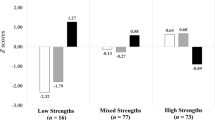Abstract
This paper describes the use of a strengths perspective in working with an adolescent with self-cutting behavior. While a disease model stresses diagnosis, labeling, medication, control, and manipulation; a strengths perspective advocates understanding of feelings and meaningfulness behind symptoms, identifying needs, and developing abilities, facilitating interpersonal communication, and building a better social environment for the adolescent client with self-cutting behaviors. A case example demonstrates this approach.
Similar content being viewed by others
References
Agoub M., Battas O., (2000) Male genital self mutilation in patients with schizophreniaCanadian Journal of Psychiatry 45(7):670–670
American Psychiatric Association. (1994). Diagnostic & statistical manual of mental disorder (4th ed.). Washington, DC: American Psychiatric Association
Applewhite L. W., Joseph M. W., (1994) Confidentiality: Issues in working with self harming adolescentsChild and Adolescent Social Work Journal 11: 279–291
Asch, S. S. (1971). Wrist scratching as a symptom for Anhedonia: A pre-depressive state. Psychanalytic Quarterly, 40(2), 603–611
Brain K. L., Haines J., Williams C. L., (1998) The psychophysiology of repetitive self-mutilationInternational Journal of Psychophysiology 30(1–2):218
Briere J., Gil E., (1998) Self-mutilation in clinical and general population samples: Prevalence, correlates, and functionsAmerican Journal of Orthopsychiatry 68(4):609–620
Burnham R. C., (1969), Symposium on impulsive self-mutilation: DiscussionBritish Journal of Medical Psychology 42: 233
Diclemente R., Ponton L., Hartley D., (1991) Prevalence and correlates of cutting behaviour: Risk for HIV transmissionJournal of American Academy of Child & Adolescent Psychiatry 30: 735–739
Favazza A. R., Conterio K., (1988) The plight of chronic self mutilatorsCommunity Mental Health Journal 24: 22–30
Fowler J. C., Hilsenroth M. J., Nolan E., (2000) Exploring the inner world of self-mutilating borderline personality patientsBulletin of the Menninger Clinic 64(3): 365–385
Gardener A. R., Gardener A. J., (1975) Self mutilation, personality & narcissismBritish Journal of Psychiatry 127: 127–132
Givoviacchni P. L., (1956) Defensive meaning of a specific anxiety syndromePsychoanalytic Review 43: 373–380
Herpertz S., Sass H., Favazza A., (1997) Impulsivity in self-mutilative behavior: Psychometric and biological findingsJournal of Psychiatric Research 31(4): 451–465
Himber J., (1994) Blood rituals: self-cutting in female psychiatric inpatientsPsychotherapy 31(4): 620–631
Hirsch M., (1998) Suicidal tendencies and self-mutilation: Overlaps and differencesForum Der Psychoanalyse 14(2): 123:138
Jeffreys S., (2000) Body art and social status: Cutting, tattooing and piercing from a feminist perspectiveFeminist Psychology 10(4): 409–429
Kafka J. S., (1969) The body as transitional object: A psychoanalytic study a self-mutilating patientBritish Journal of Medical Psychology 42: 207–212
Miller F., Bashkin E., (1974) Depersonalization and self mutilationPsychoanalytic Quarterly 43: 638–649
Milligan R. J., Waller G., (2001) Anger, impulsivity in non-clinical women. Personality Individual Difference 30(6): 1073–1078
Pattison E. M., Kahan J., (1983) The deliberate self harm syndromeAmerican Journal of Psychiatry 140: 867–872
Pao P. N., (1969), The syndrome of delicate self cuttingBritish Journal of Medical Psychology 42: 195–206
Paris J., (1998) Does childhood trauma cause personality disorder in adultsCanadian Journal of Psychiatry 43(2):148–153
Podvoll E. M., (1969) Self-mutilation within a hospital setting: A study of identity and social complianceBritish Journal of Medical Psychology 42:213–221
Rapp C., (1992) The strength perspective of case management with persons suffering from severe mental illness in: Saleebey D., (Ed.) The strengths perspective in social work practice White Plains, New York: Longman pp. 45–58
Rohricht F., Priebe S., (1997) Disturbance of body experience in schizophrenia patientsFortscrite Der Neurologie Psychiatrie 65(7): 323–336
Ross, R. R., & Mckay, H. B. (1979). Self-mutilation. New York: Lexington Books
Saleebey D., (1996) The strengths perspective in social work practice: Extension and cautionsSocial Work 41(1): 296–395
Saleebey D. (1997). Introduction: Power in people. In Saleebey D. (Ed.), The strengths perspective in social work practice (2nd ed.), (pp. 45–58). New York: Longman
Siomorpoulous V., (1974) Repeated self-cutting: an impulse neurosisAmerican Journal of Psychotherapy 28: 85–94
Simpson M. A. (1980). Self mutilation as indirect self destructive behaviour. Faberow N. L., (Ed) in The many faces of suicide. McGraw Hill, New York
Swenson C. R., (1999), A bright red scream: self mutilation and the language of painPsychiatric Services 50(9): 1234–1235
Sullivan W. P., (1997) On strengths niches, and recovery form serious mental illness in: Saleebey D., (Ed.) The strengths perspective in social work practice, (2nd ed.), (pp.183–196), New York: Longman
Sullivan W. P., Rapp C. A., (1994) Breaking away: The potential and promise of a strengths-based approach to social work practice In: Meinert R. G., Pardeck J. T., Sullivan W. P., (Eds.) Issues in social work: A critical analysis Westport, CT: Aubum House (pp. 83–104)
Suyemoto K. L., (1998) The functions of self-mutilationClinical Psychology Review 18(5): 531–554
Turell S. C., Armsworth M. W., (2000), Differentiation incest survivors who self-mutilateChild Abuse Neglect 24(2):237–249
Waska R. T., (1998) Self mutilation, substance abuse, and the psychoanalytic approach: Four casesAmerican Journal of Psychotherapy 52(1): 18–27
Walsh B. W., Rosen P. M., (1988) Self-mutilation: Theory, research and treatment, The Guilford Press, New York
Weick A., Rapp C., Sullivan W. P., Kisthardt W., (1989) A strengths perspective for social work practiceSocial Work 34(2):350–354
Yip K. S., Ngan M. Y., Lam I., (2002) An exploratory study of peer influence and response to adolescent self-cutting behavior in Hong Kong Smith studiesSocial Work 72(3): 379–401
Zanarini M. C., Ruser T., Frankenburg F. R., Hennen J., (2000) The dissociative experiences of borderline patientsComprehensive Psychiatry 41(3): 223–227
Author information
Authors and Affiliations
Corresponding author
Additional information
Prof. Kam-shing Yip is a Professor, Department of Applied Social Sciences, The Hong Kong Polytechnic University, Hong Kong, China.
Rights and permissions
About this article
Cite this article
YIP, Ks. A Strengths Perspective in Working with an Adolescent with Self-cutting Behaviors. Child Adolesc Soc Work J 23, 134–146 (2006). https://doi.org/10.1007/s10560-005-0043-4
Published:
Issue Date:
DOI: https://doi.org/10.1007/s10560-005-0043-4




